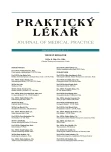Study of four POCT systems for HbA1c measurement
Authors:
B. Friedecký 1,2; J. Kratochvíla 2; J. Špirková 1; M. Budina 2; V. Palička 1
Authors‘ workplace:
Ústav klinické biochemie a diagnostiky
LF UK a FN Hradec Králové
Přednosta: prof. MUDr. Vladimír Palička CSc.
1; SEKK Pardubice
Ředitel: Ing. Marek Budina
2
Published in:
Prakt. Lék. 2011; 91(8): 485-488
Category:
Of different specialties
Overview
Four POCT systems designed for HbA1c measurement in blood were compared with a high quality laboratory method based on the HPLC principle and successfully controlled by a proficiency testing program provided by the European reference laboratory for HbA1c (in The Netherlands).
The accuracy of all the systems tested was good and covers interval CV %=2.8–5.3.
Systematic errors, calculated as differences of individual POCT systems from laboratory HPLC method are high and range in intervals from -6.7 to -9.7%.
These systematic differences cause different classifications of diabetes compensation in patients (cut off 53 mmol/mol=5,3 % IFCC). The laboratory method classified 51 (74 %) of the patients analysed to be decompensated, while POCT systems only classified between 41(57 %) to 32 (44 %) patients as decompensated from the total number of 72 assessed patients.
Our conclusion is that where well-standardised laboratory methods are available, this is sufficient for patients’ needs and POCT measurement has no additive benefits. In fact with the possible differences in the therapeutic classification, it is more likely that use of POCT could increase the risk of insufficient treatment.
Key words:
HbA1c, POCT, precision, compensation of diabetes.
Sources
1. Karen, I. Novinky v diabetologii pro VPL 2011. Practicus 2011, 4, s. 19-20.
2. Ehrmeyer, S.S., Laessig, R.H. POCT and patient safety - A partnership. Point Care 2008, 7(4); p. 223-226.
3. Nichols, J.H. (Ed.) NACB Laboratory Medicine Practice Guidelines. Evidence-Based Practice for Point-of-Care Testing, 2006 [on-line]. Dostupné na http://www.aacc.org/members/nacb/LMPG/OnlineGuide/PublishedGuidelines/poct/Pages/poctpdf.aspx.
4. Plebani, M., Lippi, G. To err is human.To misdiagnose might be deadly. Clin. Biochem. 2010, 43, p. 1-3.
5. Janssens, P.M.W. Widerspread use of point-of-care testing is irreconcidable with present day quest for safety. Clin. Chem. Lab. Med. 2010, 48(10), p. 1527-1528.
6. ČSN EN ISO 22870 : 2006. Vyšetření u pacienta (VUP). Požadavky na kvalitu a způsobilost.
7. Shephard, M.D., Mazzachi, B.C.,Watkinson, L. et al. Evaluation of a training program for device operators in the Australian Governments Point of Care Testing in General Practice. Trial: Issues and implications for rural and remote practisers. Rural. Remote. Health 2009, 9, p. 1189.
8. Shephard, M., Shephard, A., Watkinson, L. et al. Design, implementation and results of the quality control program for the Australian Governments point of care testing in general practice trial. Ann. Clin. Biochem. 2009, 46, p. 413-419.
9. Bundesärztekammer: Die Richtlinie der Bundesärztekammer zur Qualitätssicherung laboratoriumsmedizinnischer Untersuchungen. Dtsch. Arztebl. 2008, 105(7), A341-A355.
Labels
General practitioner for children and adolescents General practitioner for adultsArticle was published in
General Practitioner

2011 Issue 8
- Hope Awakens with Early Diagnosis of Parkinson's Disease Based on Skin Odor
- Metamizole at a Glance and in Practice – Effective Non-Opioid Analgesic for All Ages
- Memantine Eases Daily Life for Patients and Caregivers
- Metamizole vs. Tramadol in Postoperative Analgesia
- Memantine in Dementia Therapy – Current Findings and Possible Future Applications
Most read in this issue
- Advances in operative treatment of fractures of upper and lower extremities
- Short intervention and first aid for patients with addictive diseases
- Study of four POCT systems for HbA1c measurement
- Problematic of doping in general practice
